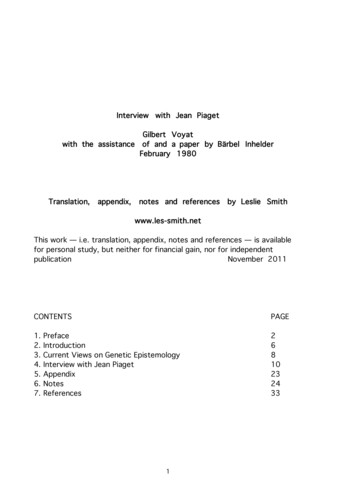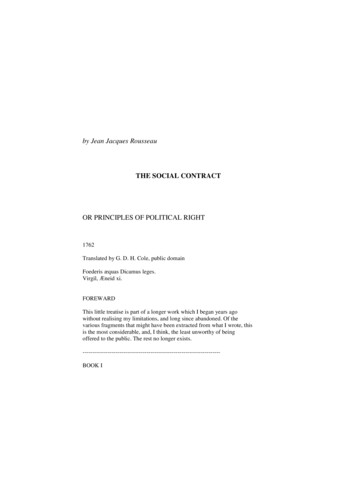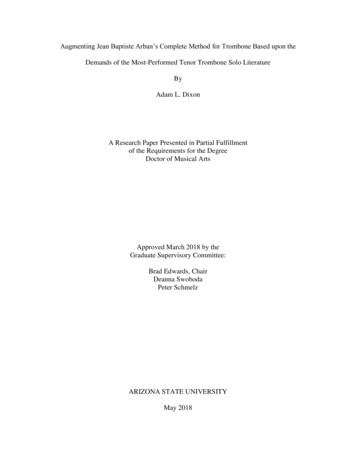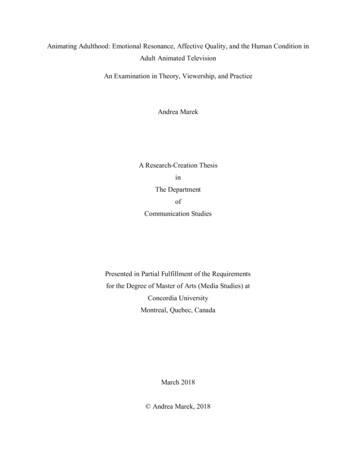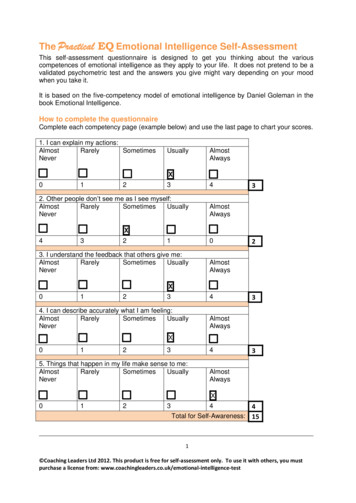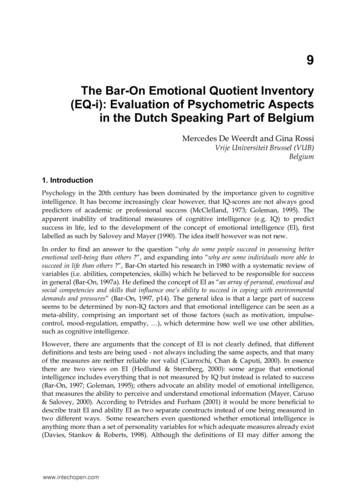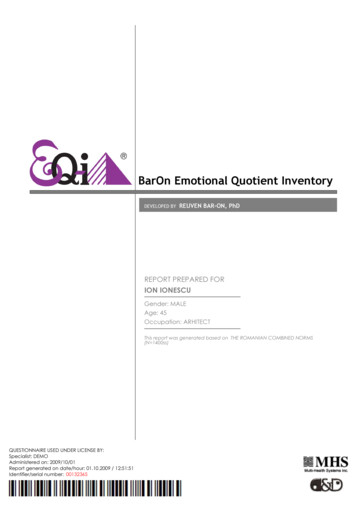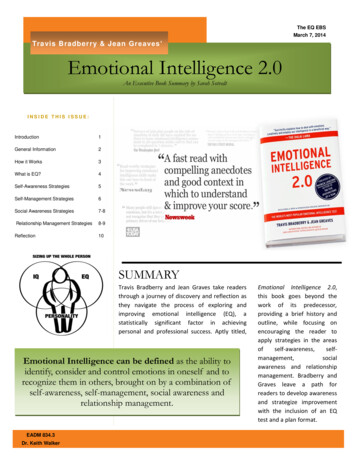
Transcription
The EQ EBSMarch 7, 2014Travis Bradberry & Jean Greaves’Emotional Intelligence 2.0An Executive Book Summary by Sarah SotvedtINSIDE THIS ISSUE:Introduction1General Information2How it Works3What is EQ?4Self-Awareness Strategies5Self-Management Strategies6Social Awareness Strategies7-8Relationship Management Strategies8-9Reflection10SUMMARYTravis Bradberry and Jean Graves take readersthrough a journey of discovery and reflection asthey navigate the process of exploring andimproving emotional intelligence (EQ), astatistically significant factor in achievingpersonal and professional success. Aptly titled,Emotional Intelligence can be defined as the ability toidentify, consider and control emotions in oneself and torecognize them in others, brought on by a combination ofself-awareness, self-management, social awareness andrelationship management.EADM 834.3Dr. Keith WalkerEmotional Intelligence 2.0,this book goes beyond thework of its predecessor,providing a brief history andoutline, while focusing onencouraging the reader toapply strategies in the ss and relationshipmanagement. Bradberry andGraves leave a path forreaders to develop awarenessand strategize improvementwith the inclusion of an EQtest and a plan format.
The EQ EBSMeet the Authors:Dr. Travis Bradberry and Dr. Jean Greaves are known for theirleading the field of emotional intelligence. They have written many books, including theprequel to Emotional Intelligence 2.0 and founded TalentSmart, a company that providesconsultation for many renowned companies and conducts research, including that referred toin this book. Reaching people in over 150 countries, these two experts ask:With 90% of top performers high in EQ, and EQ twice as important as IQ in gettingwhere you want to go in life, who can afford to ignore it?It’s All About Control: Two thirds of people are controlled by emotions. This means that themajority of the workforce is not yet skilled in gauging the emotions ofthemselves or those around them. This skill gap leads to an inability toidentify emotions or use them to the worker’s advantage. There are five core feelings in which all other emotions are rooted:happiness, sadness, anger, fear and shame. Experiencing these is natural,acceptable and unavoidable – but exploration and understanding isparamount to using, controlling and moving past them. Emotional hijacking takes place when feelings override reason, leading toreactions – often illogical or irrational – stemming purely from emotion.While the emotion itself cannot be disposed of or trained, the thoughtsand reaction immediately following can be, provided the person is awareand alert. Triggers are events leading to emotional reactions, often due to historyand experience. These, like hijackings, can be controlled.The Story Begins Using the example of a man fighting for hislife against a shark, the authors of Emotional Intelligence 2.0 demonstrate howemotional responses arise from the reasonablepart of the human brain failing to control theemotional part. Faced with the prospect of being eaten alive, the manin the story became paralyzed with fear and could not fight back. However,when chance gave him time, he made a conscious decision to retain control ofhis mind, thereby retaining control of his body. His life was saved.2
The EQ EBSSneak Peek:Once testing iscomplete, Emotional Intelligence2.0 provides simple, helpful tipslike this one:Clean Up Your Sleep Hygiene:Good sleep means enough andof quality – is important to one’sability to exercise the skillsrequired to focus on strategiesand EQ. The following arerecommended:Reset the clock by gettingtwenty minutes of natural lightin the morningThe technicalities of emotional intelligence are bestdescribed through a biological approach.Improve quality of sleepand speed of getting there byeliminating computer screenstwo hours before sleepingTrain the brain to associatebed and sleep by making thebed a home for sleepexclusive activitiesCut caffeine because itseffects are long-lasting andmake it challenging for thebrain to shut down and allowproper restThe journey goes like this:The five senses (see, hear, taste, touch, smell) send electric signals thatmust travel through the body to the brain. These signals pass throughcells in the body until reaching the base of the spine, the entry point tothe brain. They then move through the limbic system – where emotionsoccur – and ultimately reach the frontal lobe – the home of reason andrationality. Emotional intelligence, then, is awareness of thejourney and the ability to direct it, ensuring that feelings do notcontrol reactions before the brain has the chance to fully process theinformation.3“What remains constantthroughout our discoveries is thevitally important role EQ skillsplay in the quest to leads ahappy, healthy, and productivepersonal and professional life.”(Bradberry & Greaves, 2009, p. 226)
The EQ EBSTake the Test!How Do I Improve my EQ? Record your test scoresThis can be done on the “EmotionalIntelligence Action Plan” chart (included, p. 56) 2.0Select one skill to improve Answer a series of questions to determine EQYou will select from the four core skills andmay choose the skill recommended by the testor opt to start with one of your own choice Take the online test using the uniquepasscode provided by Emotional IntelligenceChoose three strategiesYou will apply these to your chosen skill and Review EQ scores and recommendedstrategies, and create an EQ Action Plan(see ‘How Do I Improve my EQ’)may choose the skill recommended by the testor opt to start with one of your own choice Find a mentorThis should bea person skillfulin the area youare working toimprove andwilling to provideobservation,feedback andregular check-ins Remember thethree PsProgress; Practice;Patience: Improvement involves time andcommitment and these require patience,practice and knowing that the end goal isprogress, not perfection Monitor improvementWhen you feel you have achieved the desiredresults in your first skill, you are encouragedto retake the test and develop a new plan“The emotional intelligence field is on thesteep incline of a new wave of understanding– how people can improve their EQ andmake lasting gains that have a profoundlypositive impact upon their lives.”(Bradberry & Greaves, 2009, p. 9)4
The EQ EBSWhat it Means to be Self-Aware“[EQ is] the singlebiggest predictor ofperformance in theworkplace and thestrongest driver ofleadership and personalexcellence.”(Bradberry & Greaves, 2009, p. 21)Self-awareness is the ability to understand one’s emotions as theyhappen. Self-awareness involves learning where one’s emotionscome from, the reasonsbehind them and howthey are displayed.Improvingselfawareness is essential tomastering the otherthree components ofEQ.Self-Awareness StrategiesQuit Treating Your Feelings as Good or BadEmotions arise for a reason. Placing judgment onthem causes a chain reaction leading to moreemotions and thus, complicating the situation. Itis best to acknowledge and explore the feelingrather than place judgment.Observe the Ripple Effect from Your EmotionsThe power of emotional reactions should not beunderestimated, particularly in regards to theireffects on others. Paying close attention to howone’s own reactions affect others and seekingfeedback is an effective way of working towardsbeing in control of the effects created.Lean into your discomfort“Rather than avoiding a feeling, your goal shouldbe to move toward the emotion, into it, andeventually through it.” (p.68) It is important tocommit to experiencing uncomfortable feelings inorder to fully understand them and know how toalter them or use them to one’s advantage.Feel Your Emotions PhysicallyUnderstanding the physical effects thataccompany specific emotions is key to earlydetection and awareness. Reflecting in detail onpositive and negative experiences in one’s pastand observing physical reactions - such asheartbeat and level of perspiration – duringreflection will help with understanding.Know Who and What Pushes Your ButtonsBecoming aware of who and what – such asspecific people or environments – causeemotions to surface will allow one to gaincontrol of associated reactions. Exploration ofthe reasons behind these causes – such asrelated past experiences – will shed light onthis subject as well.Watch Yourself Like a HawkPaying close attention one’s own behaviors,thoughts and, most importantly, emotions, isvital to a full understanding of self. Selfobservation allows time for processing theseelements.Keep a Journal About Your EmotionsRecording emotional reactions and the eventsthat led to them as well as reviewing theserecords will help to ensure self-monitoring is asimpartial and accurate as possible.Don’t Be Fooled by a Bad MoodAcknowledging that bad moods can have animpact on outlook and emotions helps toremind one that moods are only temporary andsome situations may not be met with suchnegative feelings in the future.Don’t Be Fooled by a Good Mood, EitherAcknowledging that good moods can have animpact on outlook and emotions helps toremind one to take a step back and considerthe rational side of decisions because evenpositive emotions can lead to poor decisions.5Stop and Ask Yourself Why You Do theThings You DoAll emotions are reactions, so asking ‘why’ and‘what’ is key to learning more about them.Visit Your ValuesListing personal values and beliefs helps toidentify what one stands for while recordingactions that contradicted these providesmaterial for reflection.Check Yourself.Because mood, emotion and action are closelytied, making the effort to identify one’s currentemotional state is key to controlling actionsand public persona.Spot Your Emotions in Books, Movies, and Music.Connections happen for a reason and providehelpful learning tools. Monitoring emotionalconnections with various art mediums allowsthem to become these tools.Seek Feedback.A staple for improvement, gaining theperspective of others is important in gaugingone’s self-awareness. When seeking feedback,it is advisable to request clear, directexplanations and specific examples, whenpossible.Get to Know Yourself Under Stress.Every person has different emotional andphysical responses to stress. Learning personalwarning signs is vital to being aware of stress,which in turn affects emotional control.
StrategiesSelf-Management Looks Like:The EQ EBSBreathe RightBecause the human brain requires 20% of the body’s Oxygensupply, carefully structured breathing – deep, slow consistent– will allow the rational side of the to function properly andcontrol emotions.Self-management is the act of managing one’semotions, which, in turn, manages reactions andbehaviors. After applying self- awareness to ensureemotions are understood, self-management toolsallow for self-control which can lead to strongerrelations, better communication and providing oneselfthe opportunity to act rationally and reasonably.Create an Emotion vs. Reason ListIt can be challenging to determine which side of the brain issuggesting which route. Creating a physical list helps to clarifythis differentiation.Self-ManagementMake Your Goals PublicStrategically selecting people to share goals with andrequesting assistance in monitoring personal progress can leadto better results due to an increased level of accountability.Count to TenWhen the limbic system that controls emotions takes over,rationality is overtaken. Taking the time to step back from anemotionally charged reaction by counting will automaticallyhelp your body and brain to re-adjust and allow your rationalbrain to re-enter the equation.Sleep On ItTaking time away from and to process a situation helps one togain clarity and perspective.Talk To a Skilled Self-ManagerLeading by example can be an effective self-management tool.Identifying people who are skilled in the area and modelingtheir strategies can help to improve one’s own selfmanagement practices.Speak to Someone Who isNot Emotionally Investedin Your ProblemPerspective is valuableand best gained from anoutside party, particularlyif that party also cares forthe seeker.Learn a Valuable Lessonfrom Everyone YouEncounterFlexibility of mind andemotion comes from awillingness to learn.Assuming that eachperson and situationcomes with a lesson willassist in making the mostout of interactions.Put a Mental Recharge intoYour ScheduleThe brain respondswhen the body is caredfor. Exercise helps theflow of natural systemsand recharges mind andbody, leading to betterself-management.Accept That Change is Justaround the CornerAccepting and expectingchange is key to selfmanagement. Takingtime to list potentialchanges may help withbecoming comfortablein this area.-Smile and Laugh MoreWhile negative emotions are not to be ignored, sometimes it isnecessary to override them. The human brain will respondpositively to the physical elements of smiling and laughing,providing a unique way to guide emotions.Set Aside Some Time in Your Day for Problem SolvingDecisions made abruptly tend to be less successful than thosemade in the moment. Setting aside time to consider problemsis an important to tool to assuring they are not addressedsimply through initial emotional reactions.Visualize Yourself SucceedingThe brain responds equally to what it sees in the mind and inreal life. Therefore, visualizing success in handling situationsand in adopting EQ strategies is more likely to lead to it,especially when done at night.66-
The EQ EBSSocial Awareness StrategiesGreet People by NameBecause name is crucial to identity, usingpeople’s names helps to show they arevalued.Make Timing EverythingAdopting the well-known “right place, righttime” concept is helpful when practicing socialawareness, as careful placement of questionsand responses help to control a situation andemotional reactions.Watch Body LanguageBecausebodylanguageisrevealing, paying attention to itand can be a useful tool in craftingappropriate responses.Develop a Back- Pocket QuestionHaving a generic question – especiallyone that allows for self-expression –leads to the ability to use it in anysituation to allow for more control of time orto show the other party their feelings areimportant.Don’t Take Notes at MeetingsTaking notes leaves little room for observationof others and may lead one to miss individualreactions, emotional cues and the tone of theroom.Plan Ahead for Social GatheringsHaving an action plan andfollowing through will help toeliminate stress associated withsocial commitments and, in turn,leave room for openness andobservation which will improvequality of socialization.Clear Away the ClutterFocusing on others is the goal insocial awareness. Stopping oneselffrom focusing on and interjectingwith personal ideas and responseswill create space for the otherperson to share.Live in the MomentThe present requires action, sowhile reflection and planning arenecessary to improving EQ,remembering to focus on the taskat hand is also vital.Go on a 15-minute TourBecause observation leads tosocial awareness, taking fifteenminutes to explore elements ofenvironments –such asmovement,atmosphere andmood – will help to betterunderstand the environment andits people.So, What is Social Awareness?Social awareness is about removing focus from oneself to pay attention tothe external in order to determine their emotions. This includes observingenvironments and people and requires the ability to actively pay attentionto and even accept the tones and emotions of others.7Go People WatchingWatching others is anexceptional way to learnabout how people feeland react.Always remember to self-manage; try to Take Control of Your Self-TalkThere is a close connection betweenhow people think and feel, whichmeans negative self-talk can lead tonegative self-image and make itchallenging to focus on improvingself-management. Taking steps toeliminate demeaning messages tooneself is, therefore, essential.Suggestions include:Replace negative certainties Changing certain statements (“Ialways”) to non-certainties (“Isometimes”) leaves room forchange, growth and minimizes thestatementThink in facts - Leaving judgmentout of thought in lieu of factprovides the opportunity forreflection and improvement (“Ineglected to send that” vs. “I am afailure”)Accept responsibility for youractions - Blame is almost alwaysshared - it is important to beaccountable, but equally importantnot to take on accountability forwhat others have done
StrategiesTackle a Tough Conversation: Strategic navigation of toughconversations is essential to relationship maintenance. Steps include: Only Get Mad on PurposeAnger is acceptable when using to make a pointrather than as a sudden outlet. Anger should be fullycontrolled and in a time and place strategicallychosen. Don’t Avoid the InevitableChoosing to accept and prepare for undesirable,unavoidable situations will allow for more control ofreactions to them.Start with agreement – disagreement is inevitable, but it is best tostart off on more positive groundAsk for understanding – clarifying understanding of the otherThe EQ EBSperson’s views help to avoid confusionRefrain from rebuttal – the brain listens more actively if not alreadyengaged in creating a responseOffer understanding – ensuring that the other party understandsone’s points through clear, direct, respectful communication willhelp avoid confusion on their endMove forward – in some cases, it may be necessary to respectfullyagree to disagree and initiate finding a mutually acceptableoutcome Monitor progress – maintaining contact and revisiting the issue oroutcome will encourage positive progress, pay tribute to the otherparty and ultimately strengthen the relationshipRelationship ManagementAcknowledge the Other Person’s FeelingsThough it may be uncomfortable, it is important totake the time to show an awareness of the otherperson’s feelings.Compliment the Person’s Emotions or SituationComplementing the other person indicatesunderstanding and acceptance of their position.When You Care, Show ItSmall gestures of appreciation remind people they arecared for.Explain Your Decisions, Don’t Just Make ThemOutline the process, considered alternatives andreasoning behind the outcome when decisions aremade.Make Your Feedback Direct and ConstructiveFeedback is important to anyone’s improvement, butensuring it is helpful, clearly communicated and froma place of reason rather than emotion will increasethe possibility of acceptance from the party it isprovided to.Managing RelationshipsRelationship management is the culminationof applying all other EQ components to e. Particularly applicable to workingthrough conflict, this component allows one tocombine awareness of self and others andemotion management to carefully craft andmold interactions.Align Your Intention With Your ImpactThe concept of good intentions gone awry can beeliminated with careful consideration and planning ofimplementation.Offer a “Fix-it” Statement During a Broken ConversationSometimes it is better to commit to moving forwardand looking for solutions rather than focussing onlaying blame.8
The EQ EBS(A Few More) Social Awareness StrategiesWatch EQ at the MoviesPaying attention to the emotional responses of othershelps to develop social awareness, making movies –packed with character reactions – an excellent learningtool.Practice the Art of ListeningFocusing on truly hearing the words of the otherperson will help to pull focus off of one’s own thoughtsand strengthen the interaction.Understand the Rules of the Culture GameIt is important to honor cultural demands, which canbe done by learning what people of different culturesneed and expect and to meet these when possible.Test for AccuracyObtaining clarification or confirmation of observancesis a good step in monitoring social awareness. Askingdirect questions is the best way to accomplish this.Step into Their ShoesAsking oneself to view a situation through theeyes of other people may lead to a betterunderstanding of where they stand and howthey react, and could prevent problems or assistwith amicable solutions.Seek the Whole PictureBecause feedback aids progress, seeking theviews of others – friends and foe – in regards toone’s social awareness helps to paint a biggerpicture of what is working and what shouldchange.Catch the Mood of the RoomHuman emotions tend to spread and congeal,so being sensitive to the collective tone leads toa high level of social awareness and can lead topredicting events and reactions.(A Few More) Relationship Management StrategiesTake Feedback WellBe Open and Be CuriousAvoid giving mixed signalsConstructive criticismIt is important to seek outBody language, words andcan lead to emotionalinformation about otherstone must match to properlyreactions, butwhile sharing this aboutconvey commitment to onepracticing awarenessyourself in order to increasemessage.and management ofthe possibility of strongBuildTrustself may curb these,relationships and towhich in turn protectsdecrease the likelihoodThe ability to rely on and believethe relationship atof misinterpretation.in others is integral to strongstake.relationships with them.Enhance Your NaturalHave an “Open Door”Communication StyleRemember the Little ThingsPolicyGood communication is keyThat Pack a PunchEncouraging opento healthy relationships,Small gestures can havecommunicationmaking communicationgreat effects, as can the lackhelps to buildimprovement a worthwhileof them. Adopting therelationships,step. Listing communicationpractice or incorporatingespecially isstrengths and room forsuch phrases as ‘thank-you”hierarchicalgrowth and sharingand “sorry” is a simple wayrestraints are leftassociated goals with othersto show others they areout of the equation.is beneficial.valued.9
The EQ EBSDiscussion Questions- Did anything surprise you aboutthis book or EmotionalIntelligence (EQ) as a concept?Enjoy the EQ EBS? Then you might like therest of the book! Emotional Intelligence 2.0 has several chapters that, while not vital to alesson in emotional intelligence, will be of interest to any keen student. These are: Five Dysfunctions of a Team and other books on leadership, conflict and- Have you experienced youremotions “getting the better” ofyou? Will be more equipped toteam dynamics Travis Bradberry and Jean Greaves’ company. This includes interestingreading about EQ? What wouldcomparisons in EQ statistics, including cultural and gender differences.you do differently?strong EQ or a lack of EQ?- Do you know someone whocould act as an EQ mentor orrole model for you?- What steps will you take tostart working towards EQimprovement?- How could an understanding ofEQ help to improve teamdynamics?Epilogue: A compilation of interesting facts and information that come as aresult of society’s growing interest in Emotional Intelligence and the work ofresist or understand this after- Where have you observedForeword: A brief introduction written by Patrick Lencioni, author of The Notes: Elaborations on various pieces of information and insight, organizedby chapter.Review Emotional Intelligence 2.0 provides readers with the opportunity for successfulemotional intelligence (EQ) improvement. By offering a brief explanation of the original conceptand following this with thorough explanations of each of the components within EQ, an excellentbasis in the subject matter is provided. While readers new to the work of Travis Bradberry andJean Greaves may find themselves wishing for a fuller introduction to the concept, this critique isrendered invalid given that their previous book exists to provide just that to any avid EQ fans.The test (included) is easy and provides extensive results to allow readers insight into how theyare managing their emotions. Instructions and worksheets allow the improvement planningprocess to be virtually foolproof. Arguably, the best part of the process is the option to usestrategies recommended by the test or choose different ones from the database that is this book.The strategies are well explained in origin and reasoning and provide clear steps to take. Withhelpful anecdotes along the way to paint a picture of what strong emotional intelligence is – andwhat is not – this book can only be described only as a clear, simple, entertaining and productiveread.ApplicationOne of the best features of this book is that its subjectmatter, EQ, can be applied to anything, anyone and anywhere. The statisticsmake it clear that emotional intelligence is key to workplace success for many,given that it allows one to build strong relationships, maintain positive teamdynamics, manage reactions appropriately and to be aware of when these are nottaking place. However, reading through the strategies, one discovers thatemotional intelligence is present in every facet of a person’s life. Therefore, EQimprovement can improve a person’s overall performance. Additionally, leadersshould look into EQ due to their roles as examples for others. A strong leadershould be aware of what is going on around them and equally prepared to cite andwork with those strong and weak in the area of EQ.Bradberry, J. & Greaves, J. (2009). Emotional intelligence 2.0. SanDiego, CA: TalentSmart.ReferencesSchmidt, M. (2014). Talentsmart. Retrieved from http://www.talentsmart.com10
with the inclusion of an EQ test and a plan format. March 7, 2014 I NS I DE T HI S I S S UE : Emotional Intelligence 2.0 An Executive Book Summary by Sarah Sotvedt Introduction 1 General Information 2 How it Works 3 What is EQ? 4 Self-Awareness Strategies 5 Sel

